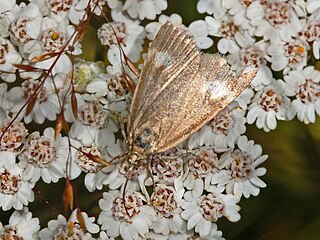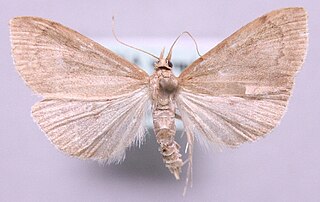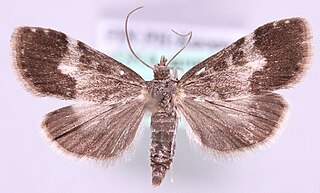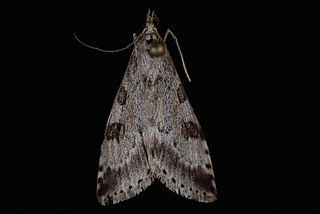
Udea fulvalis is a species of moth of the family Crambidae. It was first described by Jacob Hübner in 1809.

Udea lutealis is a species of moth of the family Crambidae described by Jacob Hübner in 1809.

Udea olivalis is a species of moth of the family Crambidae. It was first described by Michael Denis and Ignaz Schiffermüller in 1775 and is found in Europe.

Udea prunalis is a moth of the family Crambidae. It is found in Europe and China. The species was first described by Michael Denis and Ignaz Schiffermüller in 1775. In the Butterfly Conservation's Microlepidoptera Report 2011 this species was classified as common in the UK.

Udea is a genus of snout moths in the subfamily Spilomelinae of the family Crambidae. The genus was erected by Achille Guenée in 1845. The currently known 214 species are present on all continents except Antarctica. About 41 species are native to Hawaii.

Udea alpinalis is a moth of the family Crambidae. The species was first described by Michael Denis and Ignaz Schiffermüller in 1775. It is an alpine species found in Europe.

William Schaus was an American entomologist who became known for his major contribution to the knowledge and description of new species of the Neotropical Lepidoptera.
Paticiola is a monotypic snout moth genus in the subfamily Phycitinae described by Carl Heinrich in 1956. Its only species, Patriciola semicana, was described by the same author in the same year. It is known from North America, including Utah.

Cahela is a monotypic snout moth genus described by Carl Heinrich in 1939. Its only species, Cahela ponderosella, the cahela moth, described by William Barnes and James Halliday McDunnough in 1918, is found in Mexico and in the US states of California, Texas, Arizona, Utah and probably Nevada.
Cuniberta is a monotypic snout moth genus described by Carl Heinrich in 1956. Its only species, Cuniberta subtinctella, was first described by Émile Louis Ragonot in 1887. It is found in the western United States.

Udea accolalis is a species of moth in the family Crambidae described by Philipp Christoph Zeller in 1867. It is found in France, Switzerland, Italy, Austria, the Czech Republic, Slovakia, Hungary, Poland, Romania, Ukraine, Belarus, the Baltic region, Finland, Sweden and Russia.

Udea hamalis is a species of moth in the family Crambidae described by Carl Peter Thunberg in 1788. It is found from Fennoscandia south to Switzerland and Ukraine and from France east to Russia.
Udea inquinatalis is a species of moth in the family Crambidae. The species was first described by Friederike Lienig and Philipp Christoph Zeller in 1846. It is found in most of Europe and North America.
Rupela segrega is a moth in the family Crambidae. It was described by Carl Heinrich in 1937. It is found in North America, where it has been recorded from Florida, Georgia, North Carolina and Maryland.
Udea cinerea is a moth in the family Crambidae. It was described by Arthur Gardiner Butler in 1883. It is found in Chile.
Udea indistinctalis is a moth in the family Crambidae. It was described by William Warren in 1892. It is found in North America, where it has been recorded from Alberta, Saskatchewan, Washington and California.
Udea radiosalis is a moth in the family Crambidae. It was described by Heinrich Benno Möschler in 1883. It is found in North America, where it has been recorded from Alberta, Arizona, California, Montana, Nevada, Newfoundland and Labrador and Utah.

Udea washingtonalis, the Washington udea moth, is a moth in the family Crambidae. It was described by Augustus Radcliffe Grote in 1882. It is found in North America, where it has been recorded from Alaska, British Columbia, California, Montana and Washington.










